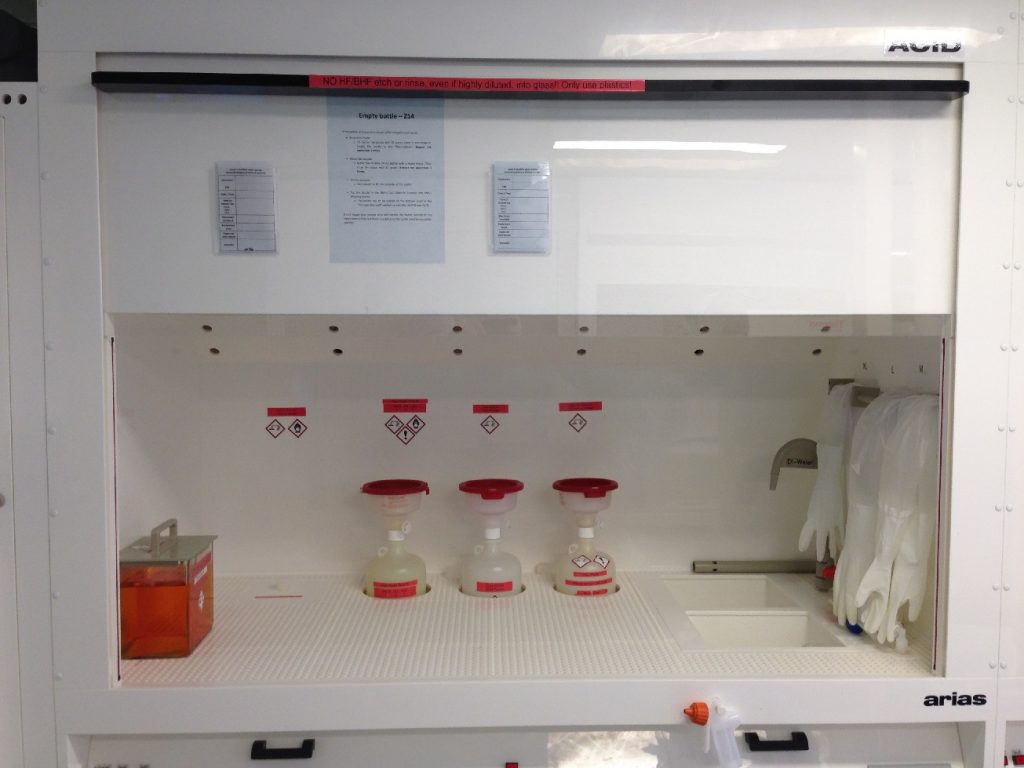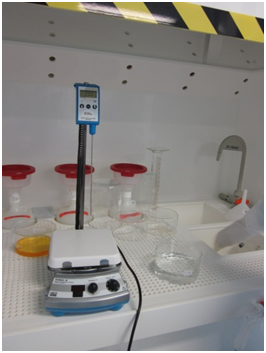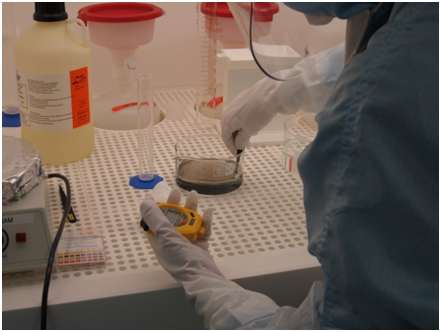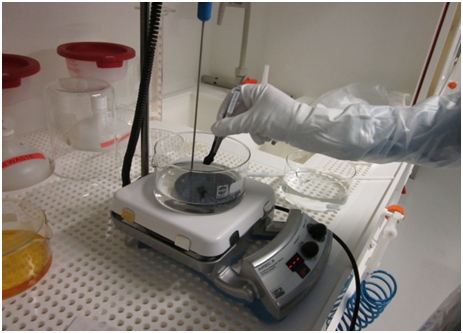
Preliminary and fundamental remark:
- SAFETY OPERATOR MANUAL TO OPERATE ON CMi WETBENCHES (HERE)
Contents
I. Introduction
Zone 14 offers three wet-benches for use of acids, bases and solvents chemistry. They are all dedicated to a given type of chemicals so they give the opportunity to use standard and/or new wet etching recipes. The bath preparation is done by the user, which allows nicely adapting the chemistry (i.e. mixtures, concentrations and temperatures) to the needed applications.
Different types of holders are available for wafers or piece parts processing: available holders.
II. Arias Acid standards
Commonly used and approved chemicals are listed in the table below.
| Materials | Chemicals | Masks | Etch rates (nm/min) | T (°C) |
| Organics | Piranha H2SO4 96% : H2O2 30% 3:1 | — | N/A Stripping/cleaning mixture Al, Ti, Cr, Cu, Ni, Ag are affected | Room temp but self-heating to >70°C |
| Pyrex | BHF NH4F 40% : HF 50% 7:1 | Cr/PR | 35 70 | Room temp 30 |
| Pyrex | Diluted HF HF 49% : H2O 1:4 | Cr/PR | 198 395 520 | Room temp 34 40 |
| SiO2 | BHF NH4F 40% : HF 50% 7:1 | PR | 30 (Borofloat) 77 (WetOx) 86 (DryOx) 80 (Fused Silica) 250-300 (LAB HRI) 225 (LTO no densification) 120 (LTO with densification) 262 (TEOS no densification) 470 (PSG) 250 (SiO2 Spider) 167 (HTO) 70 Al2O3 (ALD) 1.5 HfO2 (ALD) 329 (PECVD-Oxford N2 diluted) 273 (PECVD-Oxford Ar diluted) 219 (PECVD-Corial fast) 120 (PECVD-Corial low) | Room temp |
| SiO2 Selective on Al | AlPad Etch 639 NH4F + CH3COOH based | PR | 500 (deposited) | Room temp |
| Al | TechniEtch Al80 H3PO4 85% : CH 3COOH 100% : HNO3 70% 83:5.5:5.5 | PR | 300 | 35 |
| Al2O3 | H3PO4 85% BHF NH4F 40% : HF 50% 7:1 | PR | 72 (ALD) 120 (Spider) 70 (ALD) | 60 60 Room temp |
| aSi, PolySi | Polyetch HNO370% : HF 49% : H2O 50:3:20 | PR | 730 | Room temp |
| Pt, Al, Mo, Ni, Cu, Au | Diluted Aqua Regia HCl 37% : HNO3 70% : H2O 3:1:2 | PR | N/A Stripping/cleaning mixture | Room temp |
| Au | TechniEtch ACI2 KI + I2 based | PR | 100 | Room temp |
| Cr | TechniEtch Cr01 (NH4)2Ce(NO3)6 + HClO4 | PR | 65 | Room temp |
| Cr selective on Cu | KMnO4 + Na3PO4 60 g/l + 200 g/l | PR | 24 | Room temp |
| Ni, Cu | TechniEtch CN10 | PR | 900 (Ni) 400 (Cu) | Room temp |
| Cu | (NH4)2S2O8 + H2SO4 96% 60 g/l + 10 ml/l | PR | 200 | Room temp |
| Mo | H3PO4 85% :CH3COOH 100% : HNO3 70% 20:4:1 | PR | 125 | Room temp |
| Si3N4, SiN | HF 49% | n/a | 12 (Si3N4) 4 (LS-nitride) | Room temp |
| SiN | BHF NH4F 40% : HF 50% 7:1 | PR | 98 (PECVD-Corial fast) 37(PECVD-Corial slow) | Room temp |
III. New chemicals
If a new chemical or mixture, not listed above, is to be brought in CMi, different points must be all fully completed before introducing and using any new product:
- CMi staff is provided with detailed documentation:
– Safety Data Sheet (SDS), gathered by the user.
English version is required. Usually, this is accessible from suppliers’ website.
– Standard Operation Procedure (SOP), generated by the user (see template).
MSDS is required to complete important points of the SOP.
– Any additional information if needed. - Documentation is reviewed by a CMi committee to:
– Make a decision on the storage location and on the disposal procedure.
– Check equipment needed to ensure safe use of the product.
– Ask for modification/additional information if needed. - Upon approval from CMi:
– SDS and SOP are posted on CMi website.
– The product is introduced in CMi.
– The product is labeled with date of introduction and username.
– The product is stored at the location specified by CMi staff and mentioned in the SOP.
IV. Modus operandi
Different types of holders are available for wafers or piece parts processing: available holders.
- Login on the acid bench zone 14 (it controls the protection window)
- Lift the window using the switch on the board below the wet bench.
Be careful with optical sensors: to act on the window, nothing must be on its path.
- Put on single use nitrile gloves.
- Get a timer, plastic tweezers, spacers for bottom of beaker and the wafers ready.
- If needed, install the Heating Magnetic Stirrer. (Arec X+ Digital Thermoregular).

(1 ⇒ apron, 2⇒face shield, 3⇒chemical gloves)
- Fill a beaker with the required chemicals.
Respect the AAA rule (Always Add Acid) if you had to mix chemicals (aqua regia, Piranha…) - Place it on the Heating Magnetic Stirrer and add a magnet. The left potentiometer controls the temperature heating rate. The right one controls the rotation velocity of the magnet. The stirring is needed to have a uniform temperature.
- Set the temperature using Digital thermoregular by clicking on SET, then by adjusting the value with the arrows Cursors. When it is done click on SET. Adjust the height; the sensor must not touch the bottom of the beaker.
- Put the wafer in the chemicals using a plastic tweezers. Start the timer.
- In the case of a long process, add a cover, and label the setup (templates available on the window of the wetbench).


- When the process is done, take the wafer out (with plastic tweezers) and rinse it with 2 different beakers filled with DI water.
- If needed, additionally rinse the wafer with the DI water gun above the sink.
- Clean three times and dry the bottle used before replacing it into the cabinet.
- Put the chemicals into the corresponding waste bottle and rinse all used tool (beakers, containers, tweezers…) as necessary.
- Remove the individual protective equipment and dispose of the single use nitrile gloves.
- Perform wet bench logout on zone 14 computer.
Any droplets of any kind MUST be removed from the wetbench before leaving it.
Suspicious droplets must be diluted in DI water using a tissue (2 to 3 cleanings/rinsings are necessary) and remaining water droplets must be removed with absorbent paper.